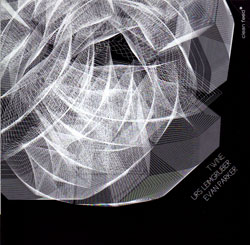
Technology doesn't just affect the sounds musicians make, it can affect how we hear them. New utilities create new contexts. As such, while the sax duo of Urs Leimgruber and Evan Parker doesn't implement any electronic wizardry, the so-called EAI aesthetic can lead the ears to some counterintuitive listening.
Parker in particular, with his remarkable Electro-Acoustic Ensemble, has been committed to the new environments of live sampling and processing within a group context and it's that context which informs and misleads, in fascinating ways, the duet record Twine. What at one time might have been scanned by the listener as "tight," as "playing together" or "sympathetic" or "symbiotic" or any of a number of other improv-discussion tropes here, strikes here as involving some form of signal processing. Which is just to say that Twine sounds strangely like a solo record, even if a decade ago that claim would have made no sense. The acculturation of the ears can be a surprising thing.
In other words, for the first 44 minutes of this session, recorded in Köln in 2007, Parker and Leimgruber, on soprano and tenor both, are in such close tandem that they sound like a single player with some sort of added auditory illusion. They echo, succeed and sit on top of each other in an ever-shifting, dizzying even, display of active listening. It's a remarkable feat — even if it feels a bit like that: a feat. The track titles, "Twine" and "Twirl," almost seem a challenge to find anything "tween." There's little gap between their horns.
"Twist," at 23 minutes the third and final track, turns the operation on its axis with a good bit of dense counter-play. It's almost old fashioned in it's sonic swirling, a good old double horn blow out. With such tasteful players, of course, it's more richly textured than just a shooting match. But with all its leap-frogging and ringing-round-the-rosie, it serves to remind just who these two major players are.
Comments and Feedback:



More Recent Reviews, Articles, and Interviews @ The Squid's Ear...


|

